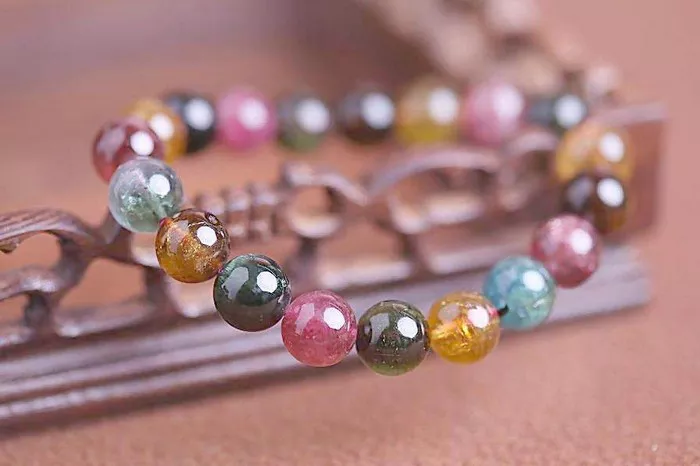Transparent pink tourmaline, a gemstone of exquisite beauty and elegance, is renowned for its captivating pink hue. Understanding the cause of this coloration requires an exploration of the gemstone’s composition and the factors that influence its appearance. This article aims to provide a detailed introduction to the causes of the color of transparent pink tourmaline, incorporating subtitles and a popular science style to make the information accessible and engaging.
Tourmaline is a complex boron silicate mineral belonging to the cyclosilicate group. Its chemical formula is complex, containing various elements such as aluminum, magnesium, sodium, lithium, and boron, along with silicon and oxygen as the primary components. Tourmaline’s chemical structure allows for a wide range of substitutions and impurities, which significantly influence its physical properties, including color.
The Role of Trace Elements
The color of tourmaline, including transparent pink tourmaline, is primarily caused by trace elements present in its crystal structure. These elements can be substituted for other elements in the mineral’s lattice, leading to changes in its electronic structure and, consequently, its color.
Manganese and Titanium
In the case of transparent pink tourmaline, the primary trace elements responsible for its pink hue are manganese and titanium. Manganese, when present in tourmaline, often results in pink or reddish colors. It acts as a color-causing agent by absorbing specific wavelengths of light and reflecting others, which we perceive as the gemstone’s color.
Titanium, on the other hand, can enhance the pink coloration in tourmaline by interacting with other elements and modifying the crystal’s electronic structure. The combined presence of manganese and titanium, along with other trace elements, can create a delicate balance that results in the desired pink hue.
Iron and Chromium
While manganese and titanium are the primary colorants in transparent pink tourmaline, other trace elements like iron and chromium can also play a role. Iron, in particular, can cause a range of colors in tourmaline, from green to brown, depending on its oxidation state and concentration. However, in transparent pink tourmaline, iron is usually present in lower concentrations and does not dominate the coloration.
Chromium, on the other hand, is less common in tourmaline but can cause intense colors such as red when present in sufficient quantities. In transparent pink tourmaline, chromium is typically absent or present in trace amounts, contributing minimally to the overall color.
The Influence of Crystal Structure
The crystal structure of tourmaline also plays a crucial role in determining its color. Tourmaline has a complex, three-dimensional crystal structure characterized by a hexagonal prismatic habit with a pyramidal termination. This structure allows for a wide range of substitutions and impurities, which can affect the gemstone’s coloration.
Charge Balance and Color Zones
In tourmaline, the crystal structure must maintain charge balance. This is achieved through substitutions of elements with different valences, which can lead to color zoning within the gemstone. Color zoning occurs when different regions of the crystal have different concentrations of color-causing elements, resulting in variations in color intensity and hue.
Transparent pink tourmaline can exhibit color zoning, with some areas appearing lighter or darker pink. This zoning can add interest and depth to the gemstone, making it more visually appealing.
The Role of Heat Treatment
Heat treatment is a common enhancement technique used to improve the color of tourmaline, including transparent pink tourmaline. This process involves heating the gemstone to high temperatures in a controlled environment to alter its coloration.
Mechanism of Heat Treatment
Heat treatment can cause changes in the crystal structure of tourmaline, leading to the redistribution or removal of color-causing elements. For example, heat treatment can cause manganese to migrate within the crystal, resulting in a more uniform color distribution. It can also cause the crystal to heal cracks or inclusions, improving its clarity and overall appearance.
Effects on Color
The effects of heat treatment on the color of transparent pink tourmaline can vary. In some cases, heat treatment can intensify the pink hue, making it more vivid and saturated. In other cases, it can lighten the color, creating a more delicate and pastel appearance.
It is important to note that heat treatment is a permanent change to the gemstone’s coloration. Once a tourmaline has been heat-treated, its color will remain altered even if it is heated again.
Conclusion
In conclusion, the color of transparent pink tourmaline is caused by a combination of factors, including the presence of trace elements such as manganese and titanium, the crystal structure of the gemstone, and heat treatment processes. Understanding these factors can help gemologists and jewelry enthusiasts appreciate the complexity and beauty of transparent pink tourmaline.Transparent pink tourmaline’s captivating pink hue, combined with its durability and rarity, makes it a highly sought-after gemstone for jewelry creation. Its unique coloration and the factors that influence it add to its appeal and value, making it a treasure for those who appreciate the beauty and intricacies of nature’s creations.
Related topic:
- Can Black Tourmaline Be Worn All the Time?
- Why Your Black Tourmaline Is Hot?
- What Constellation Is Suitable for Wearing Black Tourmaline


